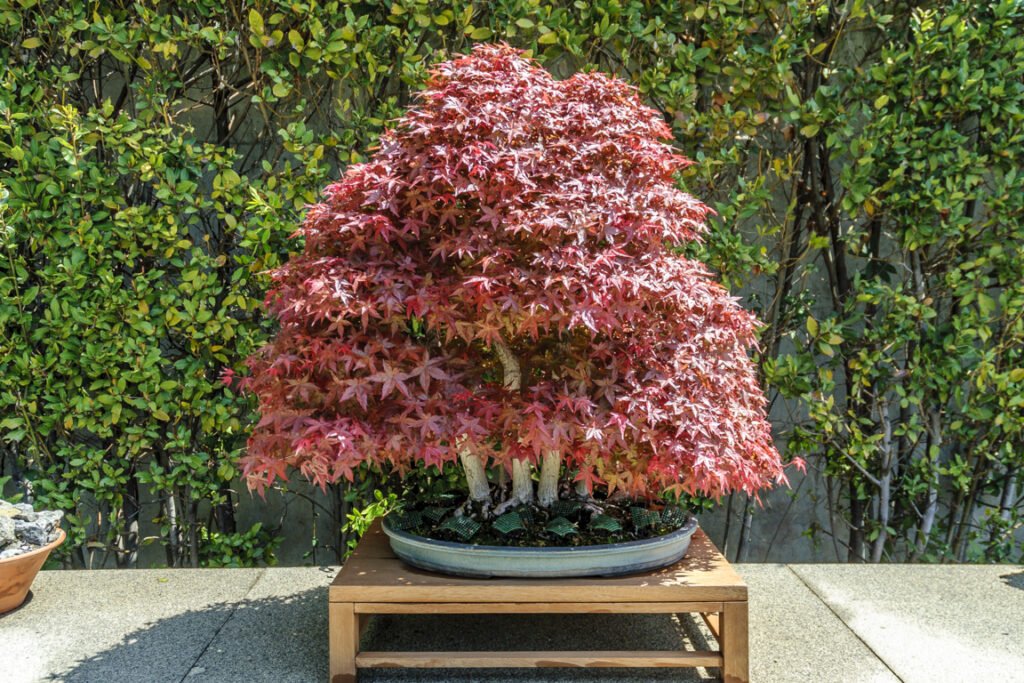
What does a dream garden look like? Is it full of lush green plants and colourful blooms? Or is it plagued by pests like ants that ruin the beauty of your garden? Everyone desires the former, but unfortunately, sometimes the latter is inevitable.
Getting rid of pesky ants in plant pots can be a challenge. But don’t worry – we’ve got your back! In this guide, you’ll learn how to get rid of ants in plants pots without harming your beloved garden.
What Danger do Ants Pose When They’re in Your Plants Pots?
Ants can cause several problems when they get into your potted plants. Below are some of the most common dangers that come with having ants in your pots:
1. Damage to roots and stems:
Ants often chew on the roots and stems of plants, causing them to weaken and eventually die. This can cause the plant to become stunted or even fail to thrive altogether.
2. Inadequate watering:
Ants tend to form nests in the soil of potted plants and can disrupt water drainage when they build up their colonies. Hence, you can face waterlogged soil – Soil that prevents the plant from getting enough water and nutrition.
3. Pest infestation:
Ants are often followed by other pests, such as aphids and mealybugs, which feed off of the plant’s sap and nutrients. Ignoring these pests may cause irreparable damage to your plants if they go unchecked.
4. Disease transmission:
Ants can transmit diseases such as root rot, which is worrisome.
Therefore, knowing how to get rid of ants in the potted plants is essential for keeping your plants healthy and thriving.
What Kind of Ants can Infest Plant Pots and How to Get Rid of Them?
There are a variety of different ants that can infest your plant pots. Some of the most common types include:
- Black ants
- Pharaoh ants
- Fire ants
- Carpenter ants
1. Black ants
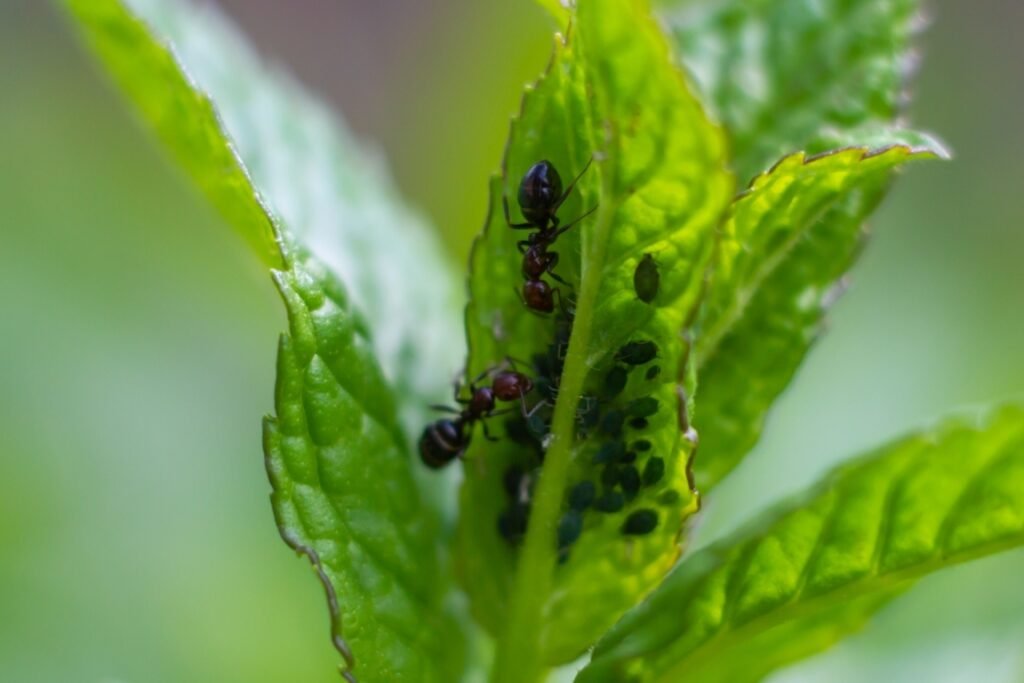
Black ants are usually found outdoors but can also get inside and establish nests in your plant pots. These ants are generally small and black, and their colonies can range in size from a few dozen to thousands of individuals.
How to get rid of black ants in potted plants?
These small creatures can wreak havoc on your plants and their soil, leading to stunted growth or even plant death. Fortunately, there are effective ways to get rid of black ants in your potted plants without harming them.
Identify the source: To eliminate them, you first need to identify their source. Ants enter potted plants through cracks in the pot, so look for signs of tiny footprints around the edges of your pots and fill in any visible cracks.
Set up traps: Once you identify the source, set up ant traps around the pot. You can use boric acid and sugar to create a sweet but deadly trap for ants. Sprinkle the mixture around the base of your plant, ensuring it’s out of reach from animals or small children.
Introduce natural predators: Introducing natural predators into your garden is another effective way to get rid of black ants. Ladybugs, lacewings and spiders will all prey on ants, so consider introducing these beneficial predators into your garden to help keep the ant population down.
Keep your garden clean: Keep your garden clean and free of debris that could attract ants. Regularly sweep up fallen leaves and remove any other material that could attract ants. Also, keep your garden well-watered to discourage ants from nesting in the soil.
2. Pharaoh ants
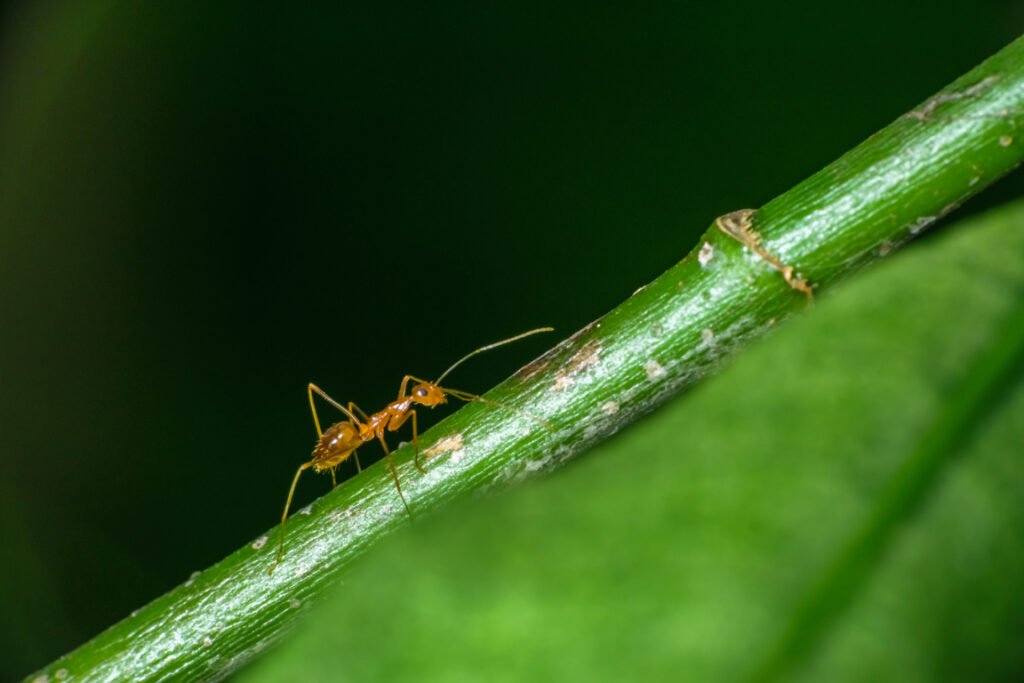
Pharaoh ants are tiny yellow or light brown ants that tend to nest indoors, often near sources of food or moisture. They are incredibly difficult to get rid of, as they can quickly establish new colonies in nearby areas.
How to get rid of pharaoh ants in potted plants?
Pharaoh ants are a type of ant that can easily infest indoor potted plants. If you have an ant problem in your potted plants, it is likely due to the presence of Pharaoh ants. Fortunately, there are several steps you can take to get rid of Pharaoh ants and prevent them from coming back.
Remove dead matter: Remove any dead or decaying organic matter from the soil and surrounding area. This can include debris such as leaves, twigs, and dirt clumps. Removing this material will help reduce the number of ants in the pot and make it more difficult for them to establish a new colony in the soil.
Create an ant barrier: Now, create an ant barrier. Line the pot’s base with a barrier that ants cannot pass through. This could include Vaseline, laundry detergent, or diatomaceous earth. Make sure all cracks and crevices are sealed off, as these are areas where Pharaoh ants may enter the soil and establish a new colony.
Use insecticides: It is also essential to use an insecticide specifically designed for Pharaoh ants. We recommend going for boric acid or fipronil.
Inspect regularly: Check your potted plants regularly for signs of Pharaoh ants. Look closely at the soil and around the base of the pot for any signs of ant activity. If you find any evidence of an infestation, take steps as soon as possible to eliminate them and prevent a recurrence.
3. Fire ants
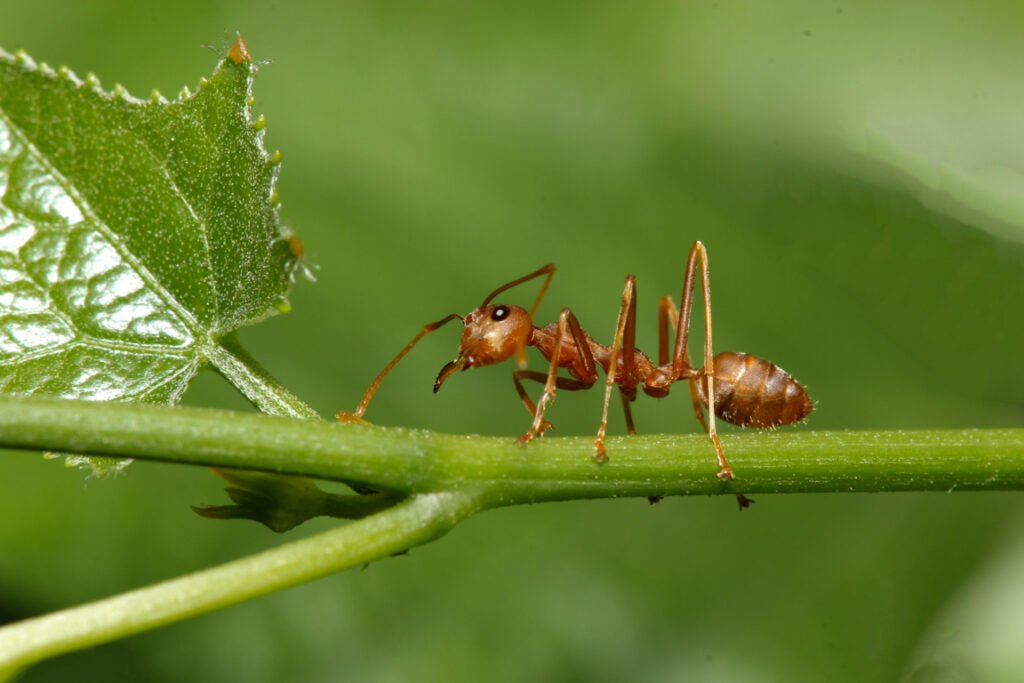
Fire ants are red or black ants that create large underground nests. They are known for their aggressive defensive behaviour and painful sting.
How to get rid of fire ants in potted plants?
Fire ants can quickly become a problem if left unchecked, and getting rid of them is essential for keeping your plants healthy and happy. Here’s what you need to do to make them disappear for good:
Inspect: Scrutinise your plants for signs of fire ant activity. Look for small mounds of dirt near the base of the plant, and inspect leaves and stems for any bites or stings.
Suck them up: If you notice ants in the soil, use a vacuum cleaner to suck them up and discard them immediately. Eliminate all the ants, not just the ones you can see.
Apply insecticide: Insecticides containing bifenthrin, permethrin or cyfluthrin can do wonders and sweep fire ants from the face of your potted plant.
Use barriers: Set up barriers to prevent future infestations. Try spreading diatomaceous earth or cayenne pepper around the area to keep them away. Alternatively, you can also use a natural ant repellent such as citrus oil or garlic water.
Watch closely: Monitor your plants closely over the next few weeks and reapply insecticides if necessary.
4. Carpenter ants
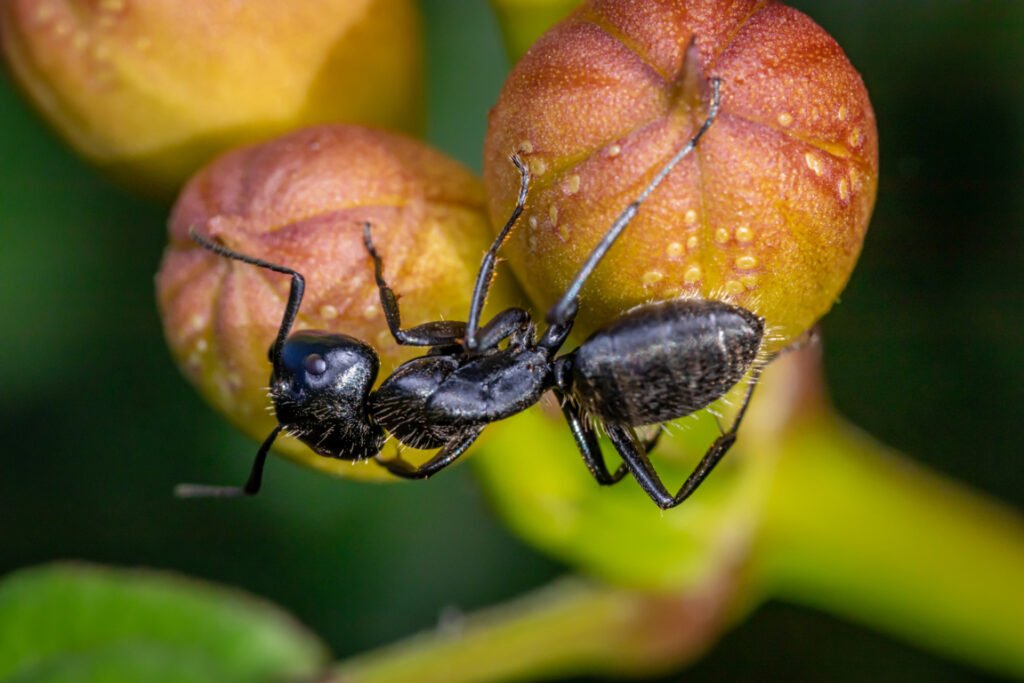
Carpenter ants are one of the largest types of ants, ranging from black to dark brown. They typically nest in rotten wood but can infect plant pots and create tunnels inside the potting mix or soil.
How to get rid of carpenter ants in potted plants?
To get rid of carpenter ants in potted plants, you must first identify the source of the infestation and then take steps to eliminate it. Here are some tips on how to do this:
Check entry points: Check around your home for potential entry points and seal them off, such as crevices or cracks in walls and floors and gaps around windows and doors.
Fill cracks with sand or gravel: If there is a void in the soil of your potted plant, fill it with sand or gravel to prevent ants from entering the pot.
Use insecticidal baits: Place near your plants to draw out the ants, then apply an ant-killing pesticide to the affected area.
Use natural repellents: Try using citrus peels and coffee grounds to repel ants from your plants.
With these tips in mind, you can easily tackle any ant infestation in your potted plants and keep them safe from future outbreaks.
How can I Make a Natural Ant Repellent at Home?
- Mix one cup of white vinegar, two tablespoons of lemon juice and one tablespoon of dish soap in a spray bottle.
- Fill the rest of the bottle with water, leaving enough room to shake it up before use.
- Shake the mixture thoroughly and spray directly onto ant trails or points of entry into your home or garden.
- Repeat the process every 2-3 days, or whenever you notice the ants reappearing.
- To repel ants from your plants, spray a mixture of half water and half white vinegar around the pot’s surroundings and on any leaves that ants may have touched.
- Keep spraying until all ants have been removed, then repeat every few days to keep them away.
- For an extra boost, add a few drops of essential oils such as peppermint or tea tree oil to the mixture and spray it around your plants.
- To keep ants from entering your home, sprinkle baking soda around entry points like windows, doors and cracks in the walls.
- Place bay leaves or cinnamon sticks around the areas where ants enter your home to repel them naturally.
- Lastly, apply a thin line of petroleum jelly around structures that may be vulnerable to ant invasions, such as windowsills, door frames and other entry points, as this will act as a physical barrier for ants.
How to Get Rid of Ants in Potted Plants Naturally
1. Use natural ant repellents
Natural ant repellents like borax, diatomaceous earth, or even coffee grounds can help naturally repel ants in potted plants.
Borax is a common ingredient found in many store-bought bug and pest sprays, so it’s effective against ants.
Diatomaceous earth is a powder made from fossilised algae, and it has microscopic edges that will cut an ant’s exoskeleton when they come in contact with it.
Sprinkle these around the base of your potted plants to stop ants in their tracks.
Coffee grounds are another natural way to repel ants since they contain caffeine, which acts as a natural insecticide.
Simply sprinkle coffee grounds around the base of your potted plants and replace them every week or so to ensure they remain effective.
2. Remove food sources
Ants need food to survive, and if you have spilt soil or debris near your plants, it can attract ants. Make sure that you clean up any soil or plant debris that accumulates near your plants.
You should also avoid over-watering your plants, as this can lead to mould and mildew, which can also attract ants.
3. Use essential oils
Essential oils are another great way to repel ants from your potted plants naturally.
Mix a few drops of essential oils with water in a spray bottle and use it to mist the base of your plants.
Some effective essential oils for repelling ants include peppermint, eucalyptus, tea tree and lavender oil.
4. Try sticky traps
Sticky traps are small strips of paper or cardboard coated with a sticky substance that will trap any ants that come into contact with it.
Place the traps near the base of your plants and check them every few days to ensure they’re still effective.
5. Plant some ant-repelling plants
Certain plants act as natural repellents for ants, such as rue or tansy.
Simply planting these in and around your potted plants can help to keep them ant-free. You can also use herbs like mint, garlic and basil as natural repellents.
By following these steps, you can get rid of ants in your potted plants naturally.
How to Get Rid of Ants on a Cantaloupe Plants in Pots?
This can be tricky, as ants tend to gravitate towards sweet foods like cantaloupe. The best way to get rid of them is by taking preventive measures like using ant baits or insecticides. You can also try some natural methods, such as using vinegar and soapy water, diatomaceous earth, or essential oils to create a barrier or repel the ants away from your cantaloupe plants. Let’s discuss the ways in detail:
Ant baits
Try using ant baits or insecticides to get rid of the ants. Place bait in areas around your cantaloupe plants, such as along window sills and door frames. Sprinkle the bait around the base of your plant pots and along the path that ants follow. This will help prevent them from reaching your cantaloupe plants.
Natural barrier
Make a natural barrier or repellent by mixing equal parts of vinegar and soapy water in a spray bottle. Shake it up and spray it around your plant pots and the walls and windowsills. The smell and taste of vinegar will deter the ants from coming around your plants.
Diatomaceous earth
Diatomaceous earth is a natural insecticide that can be used to get rid of ants. Sprinkle some around the base of your plant pots, along the walls, windowsills, and any areas the ants might use as entry points.
Essential oils
Essential oils like tea tree oil, peppermint oil, and eucalyptus oil are also effective in repelling ants away from your cantaloupe plants. Mix a few drops of the essential oil with water in a spray bottle and spritz around your plants. You can also mix a few drops of essential oil with some water and place it in cotton balls or cloths around your plants, and any entry points the ants use.
Taking these steps will help you get rid of ants on cantaloupe plants in pots, and keep them away for good.
Conclusion
Getting rid of ants in the house can be a challenging and frustrating task. However, with careful planning and a few simple steps, it is possible to eliminate ants from your home without resorting to extreme measures or expensive pest control treatments. We hope our guide on how to get rid of ants in plants pots has been helpful to you. Remember, prevention is always better than cure when it comes to ants, so keep your home clean and pest-free.
Frequently Asked Questions (FAQ)
How to get rid of ants in outdoor potted plants?
There are several methods for getting rid of ants in the home garden. Some of these include: sprinkling diatomaceous earth around your potted plants, using a diluted mixture of dish soap and water to spray directly onto the plant leaves, or by creating a barrier with ant repellents such as cinnamon oil or cayenne pepper. Additionally, consider using baits or traps to help control the ant population.
How to get rid of ants in indoor potted plants?
The same methods as described above can be used for indoor potted plants as well. If possible, relocate the plant outdoors and follow the recommendations provided above. Otherwise, consider using natural ant repellents such as eucalyptus oil or citrus essential oils, creating a barrier with talcum powder or diatomaceous earth, and setting out bait traps that contain sugar and boric acid.
How to get rid of ants in outdoor potted lettuce plants?
The best way to get rid of ants in outdoor potted lettuce plants is to use a combination of methods. Start by spraying the leaves with a diluted solution of dish soap and water, then sprinkle diatomaceous earth around the base of the plant.
How to get rid of ants in potted tomato plants?
Tomato plants can be particularly prone to ant infestations, so it is vital to take steps to prevent them from occurring in the first place. In addition to using the methods described above, try applying a spray made of garlic, chilli pepper and water directly onto the leaves.


